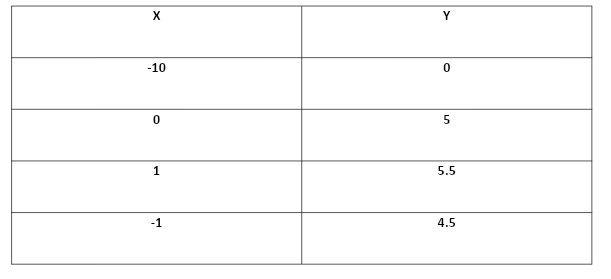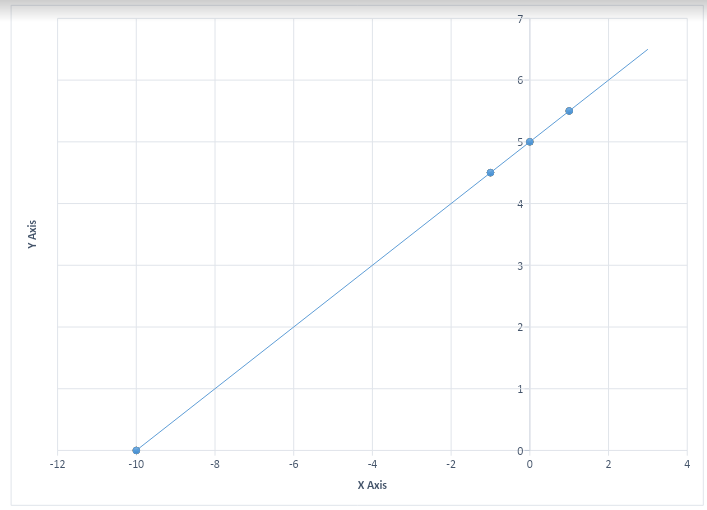
Graph the function $y = \left( {\dfrac{1}{2}x} \right) + 5.$
Answer
545.1k+ views
Hint:For plotting a graph we need different x values as well as their corresponding y values. Such that to solve this question we need to find the x intercept, y intercept and some intermediate values. Also the x-intercept and y-intercept can be found by substituting y=0 and x=0 respectively. After finding these values we just need to plot them on the XY plane.
Complete step by step solution:
Given
$y = \left( {\dfrac{1}{2}x} \right) + 5.......................\left( i \right)$
Now we need to find the x intercept, y intercept and some intermediate values for plotting the graph.
X intercept is the point where the graph touches X axis such that y=0, such that substituting y=0 in (i):
\[
\Rightarrow y = \left( {\dfrac{1}{2}x} \right) + 5 \\
\Rightarrow 0 = \left( {\dfrac{1}{2}x} \right) + 5 \\
\Rightarrow \left( {\dfrac{1}{2}x} \right) = - 5 \\
\Rightarrow x = - 5 \times 2 \\
\Rightarrow x = - 10.................\left( {ii} \right) \\
\]
\[\therefore {\text{x intercept}} = \left( { - 10,0} \right)\]
Now we need to find y intercept:
So we have to put x=0 in (i) since y intercept is the point where the graph touches the Y axis.
$
\Rightarrow y = \left( {\dfrac{1}{2}x} \right) + 5 \\
\Rightarrow y = 0 + 5 \\
\Rightarrow y = 5...................\left( {ii} \right) \\
$
Now let’s find some intermediate points:
y intercept 0,5
For x=1:
$
\Rightarrow y = \left( {\dfrac{1}{2}x} \right) + 5 \\
\Rightarrow y = \left( {\dfrac{1}{2} \times 1} \right) + 5 \\
\Rightarrow y = 0.5 + 5 \\
\Rightarrow y = 5.5 \\
$
$\therefore \left( {1,\;5.5} \right)\;{\text{is}}\;{\text{a}}\;{\text{point}}{\text{.}}$
For x=-1
$
\Rightarrow y = \left( {\dfrac{1}{2}x} \right) + 5 \\
\Rightarrow y = \left( {\dfrac{1}{2} \times - 1} \right) + 5 \\
\Rightarrow y = - 0.5 + 5 \\
\Rightarrow y = 4.5 \\
$
\[\therefore \left( { - 1,\;4.5} \right)\;{\text{is}}\;{\text{a}}\;{\text{point}}{\text{.}}\]
Now all these values which we have got from above is to be plotted in a XY plane.
Plotting the points
\[\left( { - 10,0} \right)\],$\left( {0,5} \right)$,$\left( {1,5.5} \right)$,\[\left( { - 1,\;4.5} \right)\]

On plotting the above points we get the following graph:

The above graph shows the plot of $y = \left( {\dfrac{1}{2}x} \right) + 5.$
Note:While approaching a similar graphical question one should find as many points as possible from the given conditions and common knowledge. Also one must be careful while doing the solution. Also while plotting the graph one must choose appropriate scale considering the values that should be plotted.
Complete step by step solution:
Given
$y = \left( {\dfrac{1}{2}x} \right) + 5.......................\left( i \right)$
Now we need to find the x intercept, y intercept and some intermediate values for plotting the graph.
X intercept is the point where the graph touches X axis such that y=0, such that substituting y=0 in (i):
\[
\Rightarrow y = \left( {\dfrac{1}{2}x} \right) + 5 \\
\Rightarrow 0 = \left( {\dfrac{1}{2}x} \right) + 5 \\
\Rightarrow \left( {\dfrac{1}{2}x} \right) = - 5 \\
\Rightarrow x = - 5 \times 2 \\
\Rightarrow x = - 10.................\left( {ii} \right) \\
\]
\[\therefore {\text{x intercept}} = \left( { - 10,0} \right)\]
Now we need to find y intercept:
So we have to put x=0 in (i) since y intercept is the point where the graph touches the Y axis.
$
\Rightarrow y = \left( {\dfrac{1}{2}x} \right) + 5 \\
\Rightarrow y = 0 + 5 \\
\Rightarrow y = 5...................\left( {ii} \right) \\
$
Now let’s find some intermediate points:
y intercept 0,5
For x=1:
$
\Rightarrow y = \left( {\dfrac{1}{2}x} \right) + 5 \\
\Rightarrow y = \left( {\dfrac{1}{2} \times 1} \right) + 5 \\
\Rightarrow y = 0.5 + 5 \\
\Rightarrow y = 5.5 \\
$
$\therefore \left( {1,\;5.5} \right)\;{\text{is}}\;{\text{a}}\;{\text{point}}{\text{.}}$
For x=-1
$
\Rightarrow y = \left( {\dfrac{1}{2}x} \right) + 5 \\
\Rightarrow y = \left( {\dfrac{1}{2} \times - 1} \right) + 5 \\
\Rightarrow y = - 0.5 + 5 \\
\Rightarrow y = 4.5 \\
$
\[\therefore \left( { - 1,\;4.5} \right)\;{\text{is}}\;{\text{a}}\;{\text{point}}{\text{.}}\]
Now all these values which we have got from above is to be plotted in a XY plane.
Plotting the points
\[\left( { - 10,0} \right)\],$\left( {0,5} \right)$,$\left( {1,5.5} \right)$,\[\left( { - 1,\;4.5} \right)\]

On plotting the above points we get the following graph:

The above graph shows the plot of $y = \left( {\dfrac{1}{2}x} \right) + 5.$
Note:While approaching a similar graphical question one should find as many points as possible from the given conditions and common knowledge. Also one must be careful while doing the solution. Also while plotting the graph one must choose appropriate scale considering the values that should be plotted.
Recently Updated Pages
Master Class 12 Business Studies: Engaging Questions & Answers for Success

Master Class 12 Economics: Engaging Questions & Answers for Success

Master Class 12 English: Engaging Questions & Answers for Success

Master Class 12 Maths: Engaging Questions & Answers for Success

Master Class 12 Social Science: Engaging Questions & Answers for Success

Master Class 12 Chemistry: Engaging Questions & Answers for Success

Trending doubts
What is meant by exothermic and endothermic reactions class 11 chemistry CBSE

Which animal has three hearts class 11 biology CBSE

10 examples of friction in our daily life

One Metric ton is equal to kg A 10000 B 1000 C 100 class 11 physics CBSE

1 Quintal is equal to a 110 kg b 10 kg c 100kg d 1000 class 11 physics CBSE

Difference Between Prokaryotic Cells and Eukaryotic Cells




